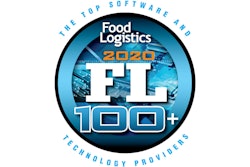
Visibility has become a key word in the food chain, as partners seek more convenience in shipping and greater knowledge of where their product is and where it came from. In addition to this, faster and safer delivery is paramount. In 2020, digitization has become apparent, and applications help make jobs easier and operations more intelligent.
Right now, app investment is almost more important than ever. Logistics partners are looking to invest in technology to optimize their business, and those that have not adapted are already falling behind. The growth of faster home delivery demands in addition to the effects of the novel coronavirus (COVID-19) have only compounded this.
“It is so important now more than ever for logistics companies to invest in mobile apps and software that will sustain and empower their business through the COVID-19 pandemic and onward,” says David Giannetto, chief executive officer of WorkWave. “Consumers are increasingly looking for fast, contactless ways to receive not only essentials like groceries and household items, but also other items like restaurant delivery, clothing, books, etc. Many logistics companies saw an influx in demand during the quarantine period, and we do not expect this demand to subside anytime soon, even after the quarantine ends.”
Types of tech
Proof-of-delivery apps are very important in the cold chain world, as it eliminates cumbersome paperwork processes and offers robust data. These apps are similar to and often integrated with features that allow partners to track drivers’ specific locations. Partners receiving these shipments can be prepared by knowing the exact timing, and customers can feel safe knowing where their products are in real time. This is true for both business-to-business and business-to-consumer operations. With so many unknowns on the road, this type of technology can make a big difference.
“Food distributors and retailers need to be far more agile than they were in the past, responding to changes in customer demand quickly, without incurring prohibitive costs,” says David Shaw, strategic partnerships manager at Paragon Software Systems, an Aptean Company. “It’s not just COVID-19 that’s driving rapid, constant change to delivery requirements. Add weather events, outbreaks of foodborne illnesses and other trends to the sudden uptick in home deliveries we’ve experienced this spring, and you have a volatile marketplace. Route optimization technology is responding accordingly.
“For example, Aptean’s electronic proof-of-delivery app, Paragon fleXipod, which is well-suited to handle the huge recent increase in food home deliveries, has a ‘Track My Driver’ function that allows the end-customer [to] see a delivery driver’s location in real time. Consumers getting groceries delivered expect more transparency than they get with an Amazon package; this allows them to get the same visibility as with an Uber car service. We’re also constantly improving the amount of information retailer and wholesaler end-customers receive about upcoming deliveries, so they can plan their own activities, such as stocking shelves, or picking and packing orders more effectively,,” adds Shaw.
Some apps focus on route planning and optimization, which grants companies the ability to set various parameters such as weight limits, duration and shift patterns, allowing the software to think intelligently about mapping. This type of software often looks at both the route with the fastest time in addition to what would be the optimal customer experience.
“Route planning is a term that can be interchangeable with route mapping and route sequencing, yet route optimization takes routing to the next level,” continues Giannetto. “Route optimization allows a company to set up different parameters that cause the software to think about routing the same way management thinks about routing, making sure that through optimization not only do they gain efficiency, but also still give the customer the experience that management wants. Companies can set parameters for just about everything, including vehicle weight limits, drive time and shift patterns (things that all factor into the optimization question), and also allow it to balance speed of delivery vs. overall efficiency. All of these elements of your everyday workflow are factored in to instantaneously optimize routes to achieve your goals.”
Various forms of scanning are also growing in importance for mobile apps, especially during a pandemic when companies are required to limit physical interaction between individuals. For instance, there are a variety of new technologies that allow logistics partners to scan packages ensuring drop-off or pickup completion. As shipping partners see higher delivery volumes, this helps grow visibility. Mobile apps pave the way for an easier scanning process, as many workers can use smartphone and tablet devices to scan.
“Apps such as Vector's touchless freight document scanner are helping to reduce errors in shipping and receiving as well as make the driver's job less stressful,” says Brian Belcher, COO and co-founder of Vector. “The app will run on any smartphone or tablet and can be set up in minutes. Data is easily retrieved at a fleet's office using APIs/plug-ins with existing freight management software.”
Listen to our podcast on visibility here:
Technological stumbles
As technology grows and becomes more embedded in the supply chain process, along with it comes growing pains. Since many companies operate on different platforms, there can be miscommunication and missed data. There is also often a learning curve with new apps, which means on first launch, the outcome is not always successful.
It is also extremely important for companies to choose the best software for their operations, as some apps may not be as useful for everyone. Managers should avoid the “shiny object” syndrome in which they jump on board a new technology because it is new without weighing how it will actually fit into and improve a business’ operations.
“Sometimes new apps might not deliver the feature and functionality needed to be successful, especially ones that have less dynamic routing abilities and do not provide important features that allow for increased customer communication, employee communication and vehicle tracking,” adds Giannetto. “It is important to look for apps that are extensions of personalized routing software that takes into consideration small, but important details.”
However, some technology providers note that it is much easier now to launch a new app within a food logistics company than in previous years.
“It’s a lot easier to implement new technology than it used to be,” continues Shaw. “At Paragon, an Aptean Company, we focus on making implementation fast and easy, industry-specific, closely supported and in stages if need be. Any new app is going to involve a learning period, and possibly some disruption to business processes. But, with the kind of disruptions going on in the food industry right now, the need for sophisticated logistics technology that can be up and running within two business weeks, gets more urgent every day. Therefore, the real pitfall is in failing to take advantage of the incredible range of capabilities out there.”
Grocery delivery
There will likely be an even heavier reliance on technology moving forward after the pandemic, as home delivery in the grocery sector becomes more prevalent. While these processes are needed right now to help coincide with social distancing, customers will likely become more comfortable with these technologies and realize their benefits. This will change the way the food supply chain operates, as more last-mile delivery demand occurs.
Home delivery in food is primarily managed through mobile apps, which means retailers will have access to more data than before to better predict the behavior of their customers. This will help with demand and moving product within the cold chain.
“The pick-up and delivery of goods, what is called the ‘last-mile’ industry, is one of the industries that will be permanently impacted in a positive way from the pandemic,” says Giannetto. “It has changed the way people think and has made home delivery even for more mundane goods, acceptable. We predict that this high demand for delivery will only continue as social distancing measures continue to evolve. Even when businesses start to open back up, there will still be a great amount of higher risk individuals who will be turning to food delivery to solve their essential needs. With all the increased demand, businesses need to truly adapt to a mobile approach by automating their businesses and processes, digitally transforming to meet these needs.”
Software has made a significant impact in food logistics and will continue to do so as technology continues to grow. Visibility is imperative in the supply chain right now, especially during this pandemic. Apps that relate to this and route optimization will become more popular with logistics providers.




















